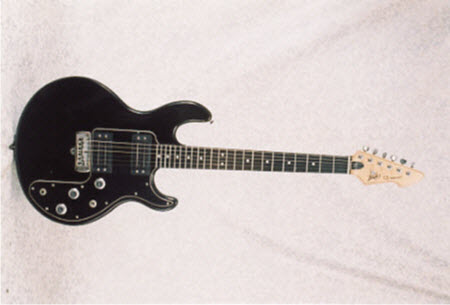
Any time you identify a “first,” there’s always some other dude who shows up to spoil the party and own the claim. However, I think it’s safe to assert that the first company to use computer numerical control (CNC) carving machines to build guitars in the U.S. was Peavey Electronics. About the same time in Japan Fujigen Gakki began employing similar technology, so who has bragging rights to the true first may never be settled, if any of us care.
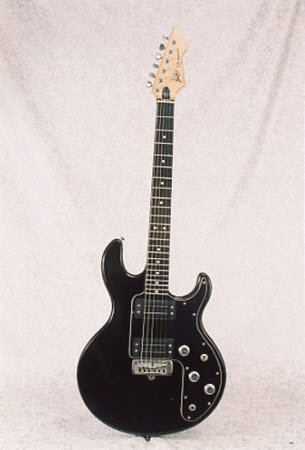
Vintage 1980’s Peavey T-25 Electric Guitar
I guess if you have a job working for Peavey in Mississippi you care about CNC-carved guitars because they help feed your family. In any case, I don’t think there are any production guitars made today that don’t come out of a CNC machine, so Peavey was a real pioneer who rarely gets the credit that’s deserved.
According to Hartley Peavey, the original idea for using CNC machines to help build guitars came from the manufacturing of gun stocks, as in rifles and shotguns. Peavey’s chief designer Chip Todd started working on the idea as early as around 1975. Along the way Chip and his crew worked with Hollywood steel guitarist and amp repairman Orville “Red” Rhoads to come up with that nifty circuitry where the guitar is wired so that the tone pot works as a coil tap when it’s turned down below 7 or 8. Peavey also developed and patented a new “bilaminated” neck, which basically fused two pieces of maple with the grain going in opposite directions to combat warping. The result was the T-60 (two humbuckers) and T-30 (three single-coils) guitars and T-40 bass, which were introduced in early 1978. The “T” prefix was shorthand for Todd, though it later got reinterpreted to stand for “Technology.” I’ve always thought the T-60 was a really handsome axe, although I’ve never warmed to frets hammered right into the neck. Obviously, not everyone feels the way I do.
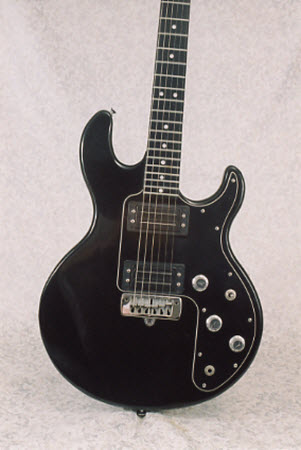
Vintage 1980’s Peavey T-25 Electric Guitar
Originally the T-60 was made of natural-finished ash, but later sunburst finish and I think maple body options were added, as well as a rosewood fingerboard for curmudgeons like me. Peavey’s T-60, T-30, and T-40 were a little, how shall we say, 1970s in their look. They must have been moderately successful because Peavey decided to stick with guitars.
In 1982 Peavey had Chip Todd revamp its T (now “Technology”) line, just before Todd got hired away to Fender. To the casual eye the new T guitars—T-15, T-25, T-26, and T-27—looked a lot like the previous T-60, but there were subtle changes. Todd had lightened the guitars with less dense timbers, added new high-output Super Ferrite “blade-style” pickups, and a variety of pickup configurations. The cutaways were also deepened a bit to improve access up the neck. These new Ts also came with some new finishes, including the jet black seen here and a few metallic paints, including a turquoise and a brown. To my taste, these still look a little too retro ‘70s, but it wouldn’t be long before Peavey got into the weird shapes (like the Razer) that were becoming popular with the heavy metallists of the times.
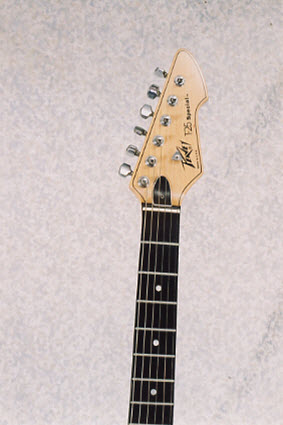
Vintage 1980’s Peavey T-25 Electric Guitar
The T-15 was a shortscale guitar with a pair of single coils and a bridge/tailpiece assembly. The T-25 seen here has twin humbuckers and the cast bridge. The T-26 had three single-coil pickups in a Strat-style configuration. The T-27 had a humbucker and two single-coils, one of the early guitars to feature this. The T-30 went back to the three single-coils. The T-25 pictured is called the T-25 Special, which presumably refers to the fact that it has a phenolic fingerboard instead of the usual maple.
I don’t think these Peaveys are especially rare, due in part to the fact that CNC machines can pretty much work as long as you want. On the other hand, these later T Series were only promoted in 1982 and by ’83 Peavey was on to the Razer et al. By mid-decade Peavey had move on into much more exotic territory with guitars with fancy figured tops and all sorts of new developments.
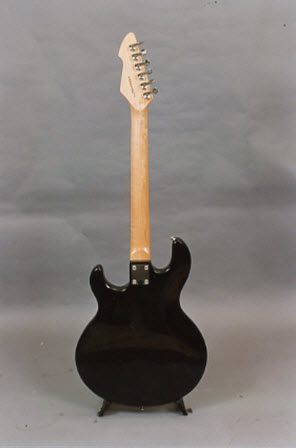
Vintage 1980’s Peavey T-25 Electric Guitar
Still, all these T Series guitars are fun to play and are relics of that seminal era when new manufacturing technology was revolutionizing how modern guitars are made. Part of Hartley Peavey’s rationale was that by using machines, he could keep guitar manufacturing here in the U.S. It’s awfully ironic that the adoption of CNC technology would make it even easier to send guitar production to developing countries where you could make them even cheaper. So, I’m not exactly sure what the reward is for being “first!”

My first guitar was a T-15 with the practice amp built into the case. I wasn’t particularly fond of it, mainly due to the weight and, in my 13-year-old eyes, didn’t look like a “rock star” guitar. Years later I kind of wish I still had it, along with the ’83 American Standard Strat I replaced it with.
I used to own an original patent pending T60. It was a nice guitar. I really liked how well built it was. It was heavy though an that’s why I sold it! It was a beast on the shoulders and back. Still a nice well built axe!
What about the 1973 to 1982 Fender Telecaster with the famous bass side neck pocket change in shape due to larger diameter tooling, which I had always heard was when they switched to CNC machines?
Estos suplementos poseen pocos efectos secundarios..
My 81 T60 is the best guitar I have ever played. Take my custom Les Pauls .My vintage Strats but die trying to take this jem.. These are being sought by serious collectors. You tube T60 .
I bought this for a gig out of town jam on Craigs list not knowing a thing. Any tone any time. Single coil.and himbuckers using the tone.knob. Still.way ahead of its time. Get one. Plays fast but so rich. I paid $325 4 years later nice ones $600 and rising.
I am looking for another in sunburst and a T26. Former recording artist so I played them all. Get one
I picked up a T-25 a few years ago for $300 including the case.. The finish is metallic blue and the condition is very, very good . I purchased the guitar on a whim after reading about the history of Peavey Guitars.
My Peavey hangs on a wall in my studio with a Peavey poster next to it which has a picture of a T-25 headstock accompanied with the statement “The Shape Of Great New Things To Come’. I think of my display as a shrine to a period which changed the electric guitar world forever.
I’m a fingerstyle player so I don’t really play the guitar much. I play repetitive exercises on my Peavey because it’s easy on my hands and arms.. Other than that it hangs on my wall.
I’ve seen a few videos (i.e. Scott Grove ) which claim these guitars belong in a class with the best guitars made today like a PRS. Well I’m not so sure about that. It’s difficult for me to believe that the design of electric guitars haven’t made significant improvements in 30 years. Never the less these early Chip Todd Peavey guitars deserve much more respect than the pawn shops most of them ended up in. Actually for the money my T-25 is really a pretty darn good compared with anything you could buy for $300 today.
.
I just got a blue t-25 as well. It had frets in very corroded shape but it actually cleaned up very well. Paid $200 at an auction.
S128 Indonesian Cockfighting Site
Gambling games that are very attached with the hearts of Indonesian people are known as
s128 cockfight gambling. Looking in Indonesia’s historical record, cockfighting games
have existed actually since the days associated with the dominion. This activity is usually not merely entertainment but is usually also
a part of a lifestyle passed down through decades of
Indonesian ancestors.
Unfortunately, although this activity is a cultural heritage of thousands of years, the Indonesian government
does not necessarily discriminate in enforcing the law until finally it is quite
difficult to look for a spot to play cockfighting in Dalam negri.
Fortunately technology invented the internet because in the particular modern era like
anyone can again access exciting games through an internet link.
Enough with the capital regarding electronic devices for example notebooks, computers or smartphones linked to
the internet, you can immediately enjoy typically the excitement of playing.
Right now there are indeed many internet gambling sites that provide similar provides on the internet,
nevertheless regrettably not all of these sites can be reliable.
Only a handful of sites have the ability to provide specialist services which can be
worthy regarding being obtained by consumers
as provided by the town of S128 Sabung Poultry.
S1288 or better referred to as S128 has been current for years serving every fan of online game cockfight gambling throughout Asia, even the
world. Hundreds of individuals are linked each week to be able to enjoy every match which is presented and you may watch the match directly through typically the
available live streaming.
There are many interesting functions that are owned by s128 as
the best chicken gambling bookie inside Asia. The following are interesting functions that you ought to know:
Live streaming!
The first advantage you can get from playing cockfighting may be
the availability of live streaming chicken battles that are usually served
in HD or high definition quality. I think very clear so that you won’t miss a solitary bit
of excitement employing S128 as your online gambling partner.
Various tournaments are available
There are numerous tournaments that you take part in all the time so zero need to be afraid
you will not get a online game because with s128 chicken matches will be present every single day and you
can take pleasure in the range of games you need.
Attractive Bonuses and Promotions
Customer comfort is a new top priority for all of us. As a result, this site has offered many interesting bonuses
in addition to promos that you can follow as an recognized
member. These bonuses plus promos are given since thanks from
s128 in order to customers for choosing them as partners to enjoy online gambling.
How to Play Chicken Gambling upon S128
All you require to do first before starting the
game is usually to register yourself since a member on the particular Betberry site.
It’s simple, visit the official Betberry website and your enrollment
menu. Complete the sign up process and you will immediately obtain a user ID and password
that you will later use to log into the game.
In 1985 I bought a T 25, including the plastic hard case for 180 dollars. 2021, I see on Reverb a T 25 for 1,100 dollars.